2024 Hyundai Santa Cruz Review: A buying guide to this compact crossover/truck

Pros: Fun and refined to drive; high-class interior; great tech; clever bed features
Cons: Cramped back seat; high price with turbo engine; slow and inefficient base engine
Pickup trucks are the best-selling vehicles in the United States and over the years, they've been growing in size and capabilities. That's great for those who will push their rig close to the limit for towing and hauling, but let's face it, not everybody needs to pull tree stumps or tow a space shuttle. Even midsize trucks such as the Toyota Tacoma and Chevrolet Colorado may exceed many shoppers' needs. That's where the revival of the compact pickup comes in.
Hyundai debuted the Santa Cruz in 2022, making it the smallest truck on the market and an intriguing choice for light-duty users. In some ways it's similar to the larger midsize Honda Ridgeline in that it's mechanically related to a crossover SUV and benefits from a smoother-riding unibody construction. Two years later, the 2024 Hyundai Santa Cruz is fundamentally unchanged, but the compact pickup truck class has grown to include the Ford Maverick.
The Maverick also rides on a unibody platform, but looks more like a traditional truck. In terms of price, it's comparable to the Santa Cruz on the low end but lacks the more luxurious top trims from Hyundai. The Maverick gains a slight advantage with its marginally larger bed but the Santa Cruz can tow up to 5,000 pounds (1,000 lbs more than the Maverick). The Maverick crushes the Santa Cruz with its 37-mpg hybrid powertrain but the Hyundai counters with more features, a nicer interior and a very generous warranty.
If anything, the Santa Cruz is perhaps more like a sporty compact SUV with a truck bed, whereas the Maverick is a miniature truck. Either way, you can’t go wrong as it really comes down to personal preference. Each is an admirable way to downsize from the larger classes of trucks.
Interior & Technology | Passenger & Cargo Space | Performance & Fuel Economy
What it's like to drive | Pricing & Trim Levels | Crash Ratings & Safety Features
What's new for 2024?
For 2024, the Santa Cruz gains a new XRT trim level (pictured above) that builds off the existing Night trim level with bed rail tie-down points, wider fender flares, matte black mirrors and door handles (versus gloss black), pedestrian/cyclist detection for the forward collision prevention system, and adaptive cruise control. Those two latter features were previously added starting with the now-discontinued SEL Premium trim level. Elsewhere, LED headlights and steering wheel haptic safety alerts are now standard on all models; dual-zone automatic climate control is included with the SEL trim; a 10.25-inch infotainment touchscreen has been added to the SEL Activity package and the Night trim level now comes with synthetic leather upholstery.
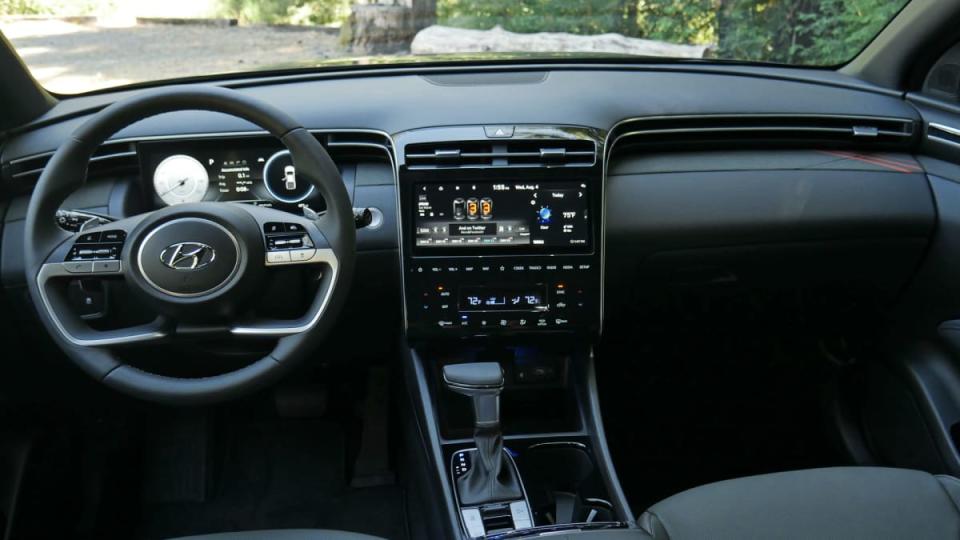
What are the Santa Cruz's interior and in-car technology like?
The Santa Cruz interior has a more premium look and feel than the typical small truck thanks to everything forward of the front seats being shared with the impressive Hyundai Tucson compact SUV. This gives the Santa Cruz a significant leg up on the Ford Maverick and justifies, at least to some extent, its higher price. In the top Limited trim, the leather upholstery, extra-mile luxury features such as ventilated seats and heated steering wheel, widescreen infotainment system and fancy-looking capacitive touch controls step things up even further.
As for the tech, Hyundai's infotainment systems, whether the standard 8-inch unit or the 10.25 widescreen one shown below, are some of the easiest to use on the market while being feature-packed and modern in appearance. We're less enamored with those capacitive controls. Though reasonably responsive, it takes too much concentration to find them with your finger amidst the glossy black expanse. Such controls have always had this problem, have always received backlash from owners and have always been replaced with conventional knobs and buttons with the next generation or sooner. We can't see the Santa Cruz being any different.
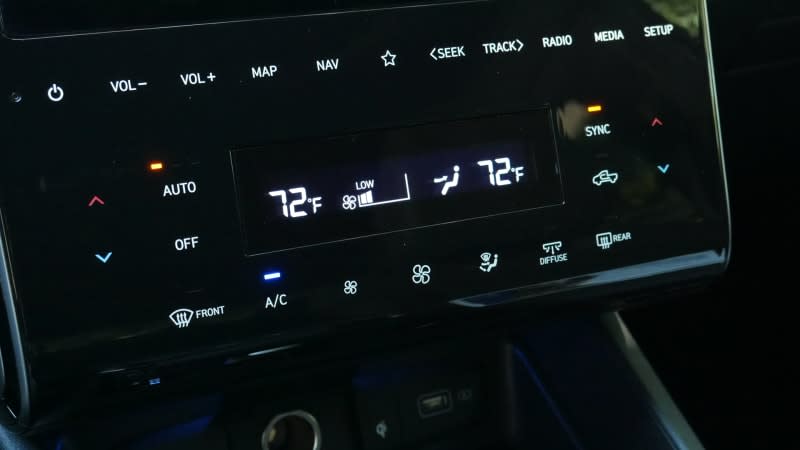
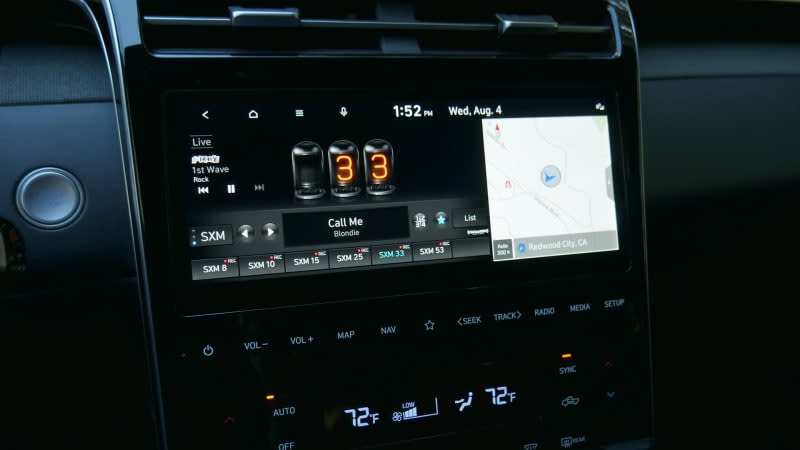
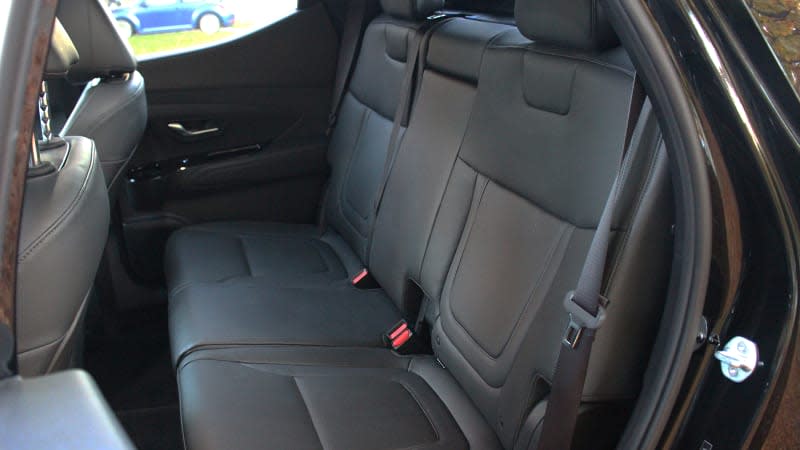
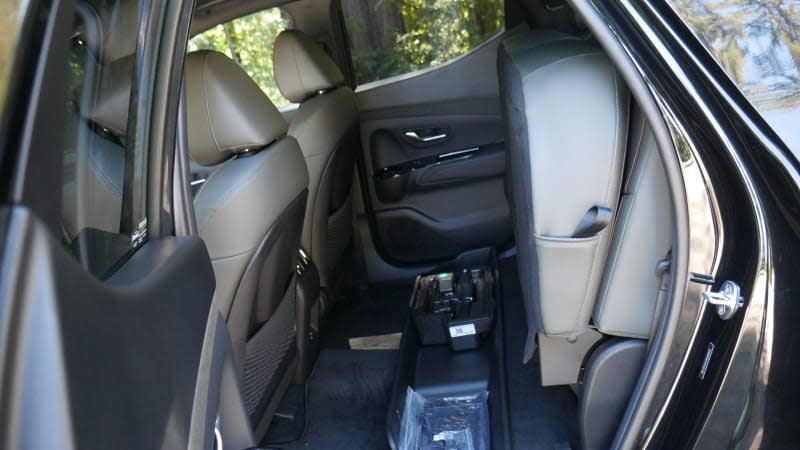
How big is the Santa Cruz?
The answer to this really depends on what you're comparing it to and which dimensions you're looking at. For a pickup, the Santa Cruz is very small at 195.7 inches in length. The smallest midsize truck, the Nissan Frontier, is 210.2 inches long in its smallest version and goes up to 224.1. Even the compact Ford Maverick is 4 inches longer. Total height differences are similarly out of whack, but the Santa Cruz has plenty of ground clearance (8.6 inches) and overall width similar to those midsize trucks (and 2.4 inches wider than the Maverick). It’s also important to note that the Santa Cruz is more than a foot longer than the mechanically similar Hyundai Tucson, which is one of the biggest compact crossovers.
That size difference with crossovers is the result of the Santa Cruz's truck bed, which is substantially longer than the cargo areas of most SUVs, regardless of segment. On the flip side, though, it's the shortest pickup bed currently on the market measuring 4.3 feet. The Ford Maverick’s is a bit bigger at 4.5 feet and more conventional in shape. What it may lack in overall capacity, however, it counters with plenty of clever features that aim to add versatility and security beyond the usual pickup experience. You can read our comprehensive Hyundai Santa Cruz pickup bed review here or watch our video about it below.
When we look inside, we flip things around again. The cabin can actually be more voluminous than the crew cabs of midsize pickups (especially the Toyota Tacoma), with a back seat that's at the very least more spacious and comfortable. Often, it's better on both fronts. Then again, the back seat has considerably less legroom than compact crossovers and its backrest angle is more upright. We also found it to be a bit less spacious and comfortable (and less accommodating to a rear-facing child seat) than the Ford Maverick in this back-seat review.
What are the Santa Cruz's fuel economy and performance specs?
The Santa Cruz SE and SEL come standard with a 2.5-liter four-cylinder that produces 191 horsepower and 181 pound-feet of torque, which is a typical amount for the base engine of a compact crossover. It is paired with an eight-speed automatic transmission and standard front-wheel drive, but all-wheel drive is available as an option. With this engine, the Santa Cruz should accelerate to 60 mph in 7.8 seconds.
EPA-estimated fuel economy is 22 mpg city, 26 mpg highway and 23 mpg combined with FWD, which is far lower than the 37-mpg Ford Maverick Hybrid. The base Santa Cruz engine returns 21/25/23 mpg with AWD, which you can’t get with the Maverick hybrid. Maximum towing capacity with this engine is 3,500 pounds with trailer brakes and 1,650 without.
The Santa Cruz Night, XRT and Limited come standard with a 2.5-liter turbocharged four-cylinder good for 281 hp and 311 lb-ft. That's more robust, especially in terms of torque, than what you'll find in some midsize pickups. Its 0-60-mph time of 6.5 seconds blows away most compact crossovers as well as the 2.0-liter Maverick. All-wheel drive is standard and the transmission is an eight-speed dual-clutch automated manual.
Fuel economy is nearly the same as the naturally aspirated base engine at 19 mpg city, 27 mpg highway and 22 mpg combined. Its maximum tow rating is 5,000 pounds with trailer brakes (the same 1,650 without), which is 1,000 pounds more than the Ford Maverick and much stronger than the typical compact crossover SUV.
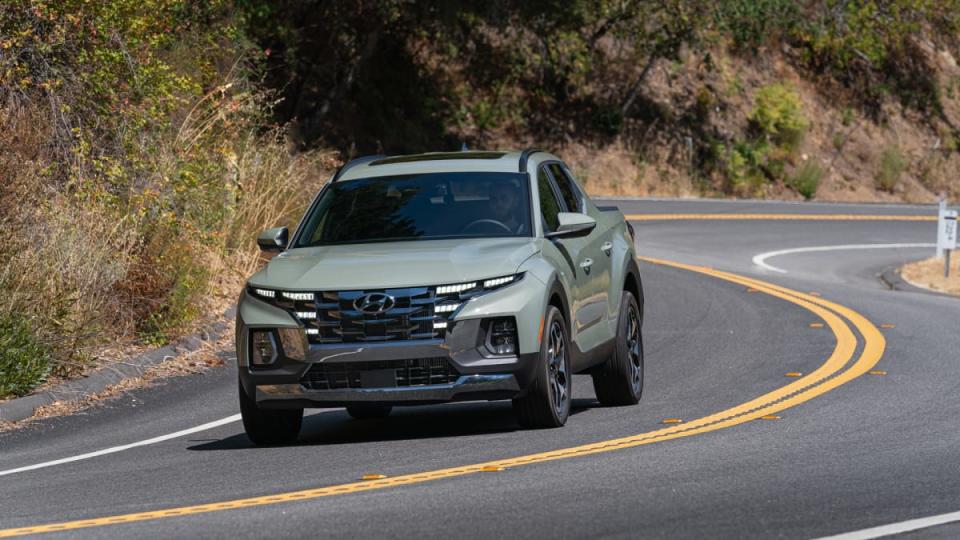

 Yahoo Autos
Yahoo Autos 
